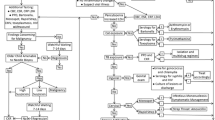Abstract
Cervical lymphadenopathy is one of the common presentations in present day surgical practise. The causes may vary from gastrointestinal malignancy indicating a grave prognosis to nonspecfic lymphadenopathy secondary to infection or trauma to the extremity which is self-limiting. Diagnosis most often requires contributions from pathologist as well as radiologist in addition to a detailed clinical examination. We are presenting a case of Kikuchi's disease which mimics tuberculosis and often leads to diagnostic dilemma.
Similar content being viewed by others
Avoid common mistakes on your manuscript.
Introduction
Patients presenting to surgical OPD with cervical lymphadenopathy is quite a common occurrence. In India where Tuberculosis is highly prevalent, we invariably suspect that as the probable cause. In this article, we report a case of Kikuchi’s disease which is still an unknown entity among surgeons in this part of the world.
Patient and Methods
A 32-year-old lady presented with history of high grade fever, cough, and left cervical lymphadenopathy of 15 days duration. On clinical examination, there were multiple nodes in left level 4 which were slightly tender, firm and discrete. Systemic examination was unremarkable. On further investigation, total count was 6200 cells/mm3 with normal absolute neutophil count and ESR was 40 mm/hr. Ultrasonography (USG) of the neck showed enlarged left cervical lymph nodes with central necrosis. USG guided Fine-needle aspiration cytology (FNAC) done twice was inconclusive. Chest X-ray was normal. As Tuberculosis was the most likely diagnosis based on history and examination, biopsy of the node was planned. It revealed acute necrotizing lymphadenitis with histiocytes (Fig. 1). Smear for AFB and TB PCR were negative. Patient was put on symptomatic treatment with NSAIDS and antibiotic (amoxyclav). Her symptoms improved in a couple of days. At two months follow up, patient is asymptomatic.
Discussion
Kikuchi’s disease is also known as Kikuchi-Fujimoto’s disease or as histiocytic necrotizing lymphadenitis, first described by Kikuchi in Japan in 1972 [1]. Exact etiology is not known although infectious and autoimmune factors have been proposed. Usually, young adults are affected. Female to male ratio is 3:1. Most commonly, it presents as an acute onset of cervical lymphadenopathy associated with fever and flu-like prodrome [2]. Rash may be present in one third of the patients [3]. Though neurological involvement is rare, ocassionally it may present with aseptic meningitis, encephalitis and acute cerebellar ataxia [4]. Laboratory findings like elevated leukocyte count and elevated ESR are nonspecific. USG shows enlarged lymph nodes with or without hyper echoic areas [5]. FNAC is most often nonspecific [6]. Diagnosis is usually made on excisional biopsy. Histological findings consistent with Kikuchi’s are paracortical necrosis with histiocytes. Tuberculosis, SLE, and malignant lymphoma are the main differential diagnosis [7]. Treatment is mainly supportive. NSAIDS are mainly used to alleviate lymph node tenderness and fever. Steroids are recommended for severe extra nodal or generalized Kikuchi’s disease [8].
Conclusion
Though rare diagnosis are rarely correct, they should always be kept in the differential diagnosis. Kikuchi’s disease mimics tuberculosis. Prompt diagnosis requires biopsy and can avoid unnecessary antitubercular treatment with antecedant side effects.
References
Kampitak T (2008) Fatal Kikuchi-Fujimoto disease associated with SLE and hemophagocytic syndrome: a case report. Clin Rheumatol 27(8):1073–1075
Lin HC, Su CY, Huang CC, Hwang CF, Chien CY (2003) Kikuchi’s disease: a review and analysis of 61 cases. Otolaryngol Head Neck Surg 128(5):650–653
Atwater AR, Longley BJ, Aughenbaugh WD (2008) Kikuchi’s disease: case report and systematic review of cutaneous and histopathologic presentations. J Am Acad Dermatol 59(1):130–136
Hedia G, Jamel A, Maher A et al (2005) Kikuchi-Fujimoto disease associated with systemic lupus erythematosus. J Clin Rheumatol 11(6):341–342
Youk JH, Kim EK, Ko KH, Kim MJ (2008) Sonographic features of axillary lymphadenopathy caused by Kikuchi disease. J Ultrasound Med 27(6):847–853
Tong TR, Chan OW, Lee KC (2001) Diagnosing Kikuchi disease on fine needle aspiration biopsy: a retrospective study of 44 cases diagnosed by cytology and 8 by histopathology. Acta Cytol 45(6):953–957
Dorfman RF, Berry GJ (1988) Kikuchi’s histiocytic necrotizing lymphadenitis: an analysis of 108 cases with emphasis on differential diagnosis. Semin Diagn Pathol 5(4):329–345
Jang YJ, Park KH, Seok HJ (2000) Management of Kikuchi’s disease using glucocorticoid. J Laryngol Otol 114(9):709–711
Author information
Authors and Affiliations
Corresponding author
Rights and permissions
About this article
Cite this article
Pai, V.D., Jadhav, R.R. Kikuchi’s Disease: A Diagnostic Dilemma. Indian J Surg 77 (Suppl 1), 164–165 (2015). https://doi.org/10.1007/s12262-015-1231-x
Published:
Issue Date:
DOI: https://doi.org/10.1007/s12262-015-1231-x





